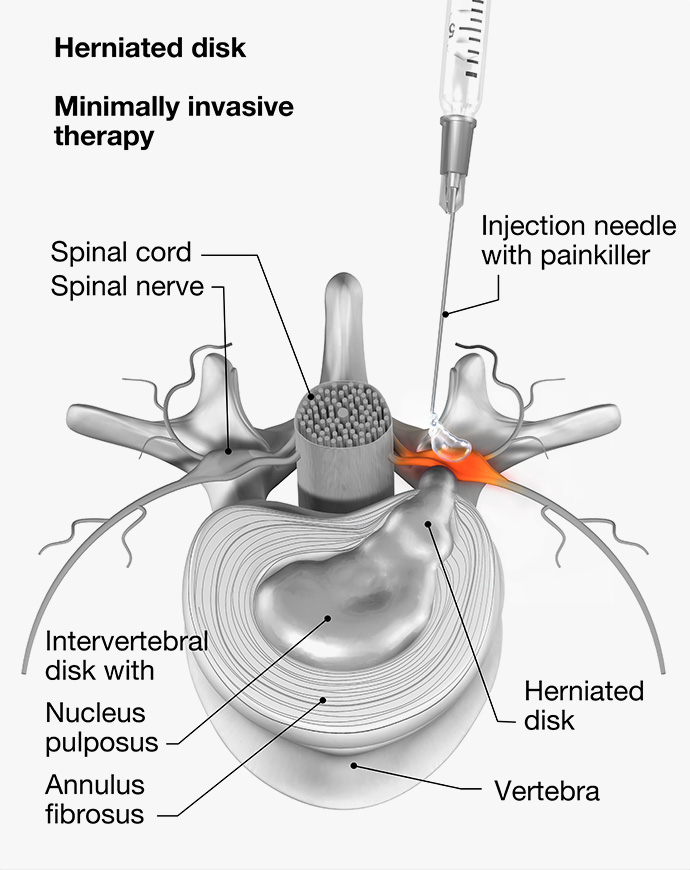Nerve Root Block Injection (Transforaminal Epidural Injection)
A nerve root injection is a procedure that is used to diagnose/treat symptoms caused by mechanical irritation of one of the nerves as it exits the spinal column. The procedure is typically performed at the cervical (neck) and lumbar (lower back) levels as these are the regions of the spine which are most frequently affected by degenerative disc disease with resultant compression/irritation of the exiting nerves.
What happens before the procedure?
Before being referred for a nerve root injection, you need to be assessed by a specialist surgeon or physiotherapist who will take a history of your symptoms and perform a thorough examination. An MRI scan will be requested if it is felt that your symptoms are due to irritation of one or more of the nerves as they exit the spine. The MRI will help to locate which nerve is most likely to be the cause of the symptoms. In patients who have an MRI scan that shows potential irritation/compression at multiple levels, a nerve root block can provide useful diagnostic information to help identify the source of your pain. This is particularly useful for the patient considering surgery.

How do I prepare for my procedure?
Please inform us if you take a blood thinning medication when you arrange your appointment as some need to be temporarily withheld beforehand. Common blood thinning medications include antiplatelets (aspirin or clopidogrel) and anticoagulants (warfarin, apixaban, dabigatran, or rivaroxaban).
Do not stop any medication before talking to us.
Frequently, the procedure can result in temporary numbness and weakness in the affected arm/leg. We therefore advise not to drive for 24 hours following the injection. Some help may be required with normal activities and it is therefore advised that you arrange for someone to bring to you to the hospital and to drive you home afterwards. Ideally you should have someone stay with you overnight.
Diabetics should closely monitor their blood sugar level before and after the procedure as the steroid medication in the injection can affect this for several days.
What happens during the procedure?
A nerve root block is performed in the hospital as an outpatient under local anaesthetic.
You will go home the same day, and not require sedation or general anaesthetic.
An experienced specialist Doctor (Radiologist) will carry out the procedure in a room with a special X-ray camera, called fluoroscopy. The injections only take a short time but the whole procedure may take up to 30 minutes.
You will be asked to lie on your front for the procedure, we will aim to make you as comfortable as possible. The doctor will then clean the skin on your neck/back with antiseptic and cover with sterile drapes.
The skin of the affected area of the neck/back will be injected with local anesthetic to numb any pain. The doctor will then guide the needle to the correct position with the help of live X-ray images. Once in a good position, the doctor will inject a small amount of X-ray dye to confirm exact location next to the nerve.
A mix of local anesthetic and steroid is then injected slowly in and around the nerve.
The needle will then be removed.
You will usually be able to go home half an hour after the procedure is finished.
What are the side effects of the procedure?
The most common side effect of the injections are slight tenderness and/or bruising at the site of the injection, this usually resolves over the first few days.
In some cases people may feel increased pain for a few days after the injection but this should settle.
More serious side effects are rare but can include bleeding, infection, nerve injury and allergic reactions to the medications used in the procedure.
It is important to seek medical help if you are feeling unwell.
How will I feel after the injection?
You may experience an immediate improvement in symptoms from the injection of local anaesthetic. This effect usually lasts for 12-24 hours.
The effect of the local anaesthetic may also result in numbness/weakness of the affected arm/leg for up to 24 hours. Take care when mobilizing especially with stairs/carrying shopping or children!
The steroid medication usually takes two to three days to have an effect and typically peaks at one-two weeks.
Regular pain relief medication can be continued as required.
The success of the injections in reducing a person’s pain and for what length of time varies with the individual.

